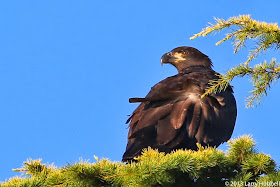For the last month a pirate has been visiting Union Bay. One must admit this hawk has a swashbuckling look with the skirt of warm feathers around its feet. In September this Red-Tailed Hawk was last seen inspecting a fenced backyard belonging to the owner of a small dog.
During the last few weeks the bird has moved across the street and has been hunting from high above Kingfisher Cove.
Kingfisher Cove is my name for the body of water to the west of the "Bridge-to-Nowhere". The bridge is west of the 520-South off-ramp that terminates in the Arboretum. This little bay is a popular, summertime swimming hole for adventurous young people.
During the rest of the year kingfishers love to sit in the lower branches of half fallen dead snags while watching for unsuspecting fish in the shallow water, hence the name Kingfisher Cove.
Curiously the resident Kingfisher this fall is a female.
Last year it was more common to see a male kingfisher at the cove.
Did you notice how they differ? The male Belted Kingfisher lacks the second lower, reddish belt that the female has.
Earlier this month the female Kingfisher was seen circling around the Red-Tailed Hawk calling out in alarm. The kingfisher's call is loud and memorable (Click here to listen to one.) but it did not seem to disturb the hawk at all. The Red-Tailed Hawk also has a very memorable call. You have most likely heard its call while at the movies. (Click here to hear one.)
The Red-Tail is most commonly seen on light poles near our freeways. Where it watches for mice, voles and other small mammals. However Red-Tailed Hawks are very opportunistic and will also eat birds, fish and most any other creature it can catch. There have been stories of chickens roaming free just on the north side of 520 (near the old MOHAI) which may be another reason for the RT to visit this area.
Having a number of different hunting strategies has enabled the RT to adapt and survive in almost every corner of North America. There is even a very well-known RT in New York City. (Click here to read more about Pale Male.)
One of the Red-Tailed Hawk's hunting strategies is to steal food from other birds. While there is most likely a wide-variety of food for the RT at Kingfisher's Cove one still must wonder if the hawk is hoping to catch the Kingfisher or like a pirate steal the tiny fish that the Kingfisher catches.
If you happen to visit the southwest corner of Union Bay keep an eye out for The Pirate of Kingfisher's Cove, you might even get to see it in action.
Have a great day on Union Bay...where nature lives in the city!
Larry
PS: It might also be interesting to watch for any interaction between the RT and our resident Bald Eagles. Some websites say the RT will chase eagles if they near its nest, but I have yet to spot a pair of RTs or a RT nest near Union Bay. In addition I have never seen the RT come even remotely close to the eagles, however they both visit Foster Island occasionally.
On another note it seems like October has been a grey and cloudy month. I just happened to catch a brief moment of sunshine that illuminated these snags against the cloudy sky. There are no birds in this photo but it does feel a bit like a rainbow to me, e.g. a promise of sunshine to come.























































